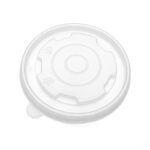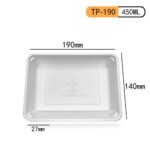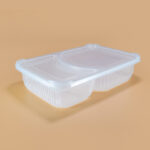Quick Summary
This blog explores the cost comparison between biodegradable clear cups and PET cups, two common types of packaging in the food and beverage industry. While biodegradable cups, such as PLA, are generally more expensive than PET due to higher raw material costs and more complex manufacturing processes, they offer significant environmental benefits. Biodegradable cups decompose naturally, reducing plastic pollution, whereas PET takes hundreds of years to break down and is not widely recycled. The growing consumer demand for eco-friendly products and the potential for improved brand image make biodegradable cups a viable choice for businesses, despite the higher cost. Ultimately, the decision depends on balancing cost, sustainability goals, and environmental impact.
Introduction
In an era where sustainability is at the forefront of consumer priorities, the shift towards eco-friendly packaging is becoming more pronounced. Among these alternatives, biodegradable clear cups are being hailed as an environmentally responsible choice, particularly in industries like food and beverage. These cups are often positioned as a better solution compared to conventional plastics like PET (Polyethylene Terephthalate). But as businesses and consumers strive for sustainability, a pressing question arises: Do biodegradable clear cups cost more than PET cups?
In this blog, we will explore the cost comparison between biodegradable clear cups and PET cups, examining the factors driving their pricing, industry data, and the wider implications of these cost differences. With real-world data and insights, we’ll uncover not only the price but also the broader environmental costs that come with each option.
1. What Are Biodegradable Clear Cups and PET Cups?
1.1 Biodegradable Clear Cups
Biodegradable cups are manufactured using materials that break down naturally over time, reducing their environmental impact compared to traditional plastics. The key types of biodegradable materials used for clear cups include:
-
PLA (Polylactic Acid): Derived from renewable resources such as cornstarch or sugarcane. PLA cups are popular in the market due to their clear appearance and compostable nature.
-
PHA (Polyhydroxyalkanoates): A group of biodegradable plastics produced by bacteria that feed on renewable carbon sources. PHA is more durable than PLA but still biodegradable.
-
Starch-Based Plastics: Made from starch extracted from plants such as corn or potatoes. These plastics decompose naturally under proper conditions but can be less transparent than PLA or PET.
Biodegradable cups are marketed as sustainable alternatives, but their performance varies depending on the material. While PLA cups offer good transparency, they require specific composting conditions to degrade fully, which can limit their environmental benefits if not disposed of correctly.
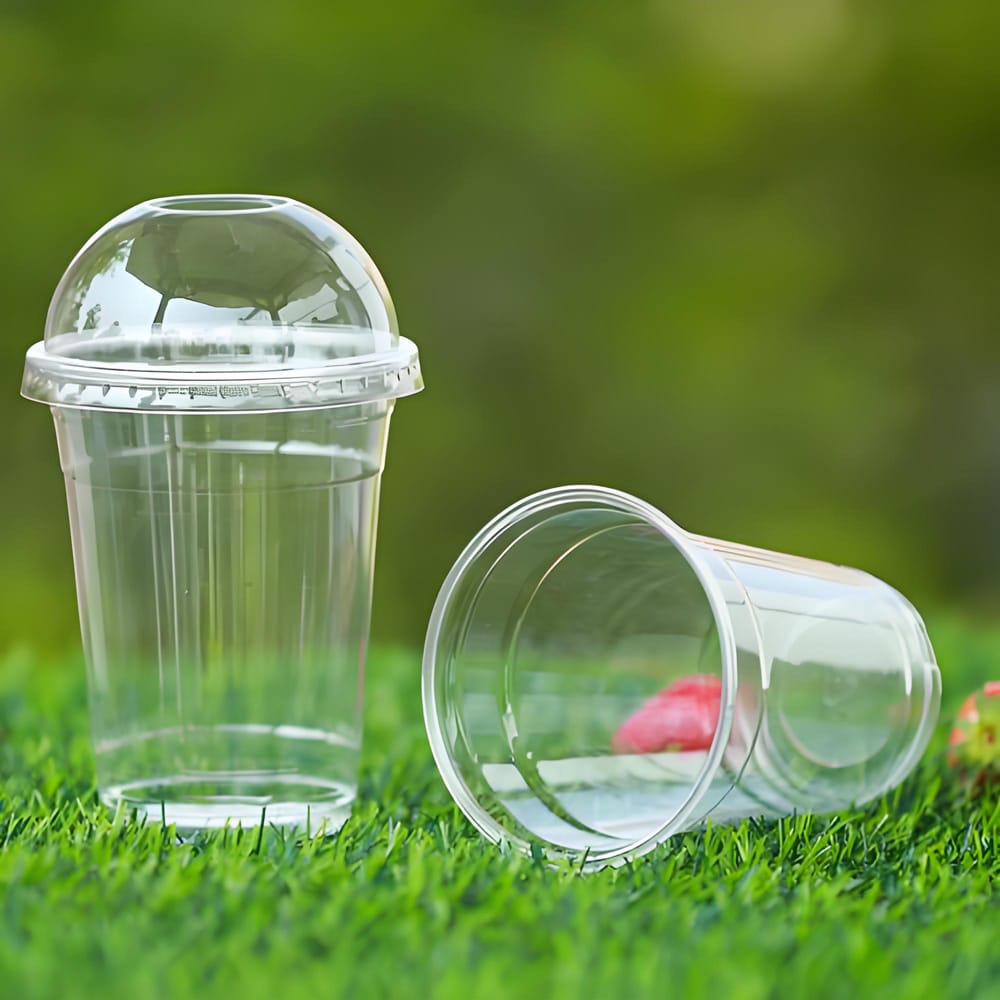
1.2 PET Cups
PET cups are made from polyethylene terephthalate, a petroleum-based plastic commonly used for a wide range of products, including beverage bottles and clear cups. PET is known for being lightweight, durable, and easy to mold into various shapes, making it a popular choice for clear cups in the food and beverage industry.
While PET is recyclable, the recycling rates for PET cups are relatively low. The recycling rate for PET in the U.S. is estimated at around 30% (according to the EPA), leading to significant environmental waste issues.

2. Cost Comparison: Biodegradable Clear Cups vs. PET Cups
2.1 Raw Material Costs
The raw material cost is one of the main drivers of price differences between biodegradable clear cups and PET cups.
-
Biodegradable Materials: The production of biodegradable plastics, such as PLA, is more resource-intensive and often involves agricultural processes. The raw materials used for PLA—corn, sugarcane, and other crops—are subject to price volatility. The prices for biodegradable plastics are also influenced by factors such as crop yields and climate conditions, making them more expensive than PET.
-
PET: PET is produced from petroleum, a commodity that has established supply chains and tends to have stable pricing compared to biodegradable alternatives. The production of PET is more straightforward, reducing raw material costs.
2.2 Production and Manufacturing
The manufacturing process for biodegradable cups is generally more complex than that of PET cups.
-
PLA Cups: PLA requires specialized machinery and conditions for production. The material needs to be processed at high temperatures, which requires additional energy and infrastructure. This additional complexity adds to the manufacturing cost.
-
PET Cups: PET is easier to produce and does not require the same level of specialized equipment. The process is well-established, and PET benefits from economies of scale, which makes it more cost-efficient in mass production.
2.3 Market Pricing for Biodegradable and PET Cups
Based on industry surveys and data, the price difference between biodegradable cups and PET cups is substantial.
-
PLA Clear Cups: The price for a typical 500ml PLA clear cup ranges from $0.12 to $0.18 per unit, depending on the manufacturer and the scale of production.
-
PET Clear Cups: The price for a similar-sized PET clear cup ranges from $0.08 to $0.12 per unit.
This means that biodegradable clear cups can cost anywhere from 20% to 40% more than their PET counterparts. This price difference is largely attributed to the higher production costs and raw material prices associated with biodegradable plastics.

3. Environmental Costs and Benefits of Biodegradable and PET Cups
3.1 Environmental Impact of PET Cups
PET cups are not biodegradable, and they can persist in the environment for hundreds of years, contributing significantly to plastic pollution. While PET is recyclable, the global recycling rate is low, with many PET cups ending up in landfills or oceans.
-
Plastic Waste Statistics: According to the United Nations Environment Programme (UNEP), the world produces over 300 million tons of plastic waste annually, and a large proportion of this waste is not recycled. A significant portion of this plastic ends up in landfills or natural ecosystems, where it takes hundreds of years to decompose.
-
Recycling Rates: In the U.S., PET recycling rates hover around 30%, meaning that the remaining 70% ends up as waste. This highlights the need for alternative packaging materials like biodegradable cups.
3.2 Environmental Impact of Biodegradable Cups
While biodegradable cups are marketed as more environmentally friendly, their environmental impact can vary. For example, PLA cups are compostable but require industrial composting facilities to break down properly. In a typical landfill, PLA cups may not degrade as quickly as intended due to a lack of oxygen and other necessary conditions.
-
Carbon Footprint of PLA: Studies show that PLA has a 20%-30% lower carbon footprint than PET, primarily due to the fact that PLA is derived from renewable plant-based resources. However, PLA production can still be resource-intensive, and the environmental impact depends on agricultural practices, transportation, and the energy used in production.
-
End-of-Life Considerations: PLA cups are best disposed of in composting facilities, which are not widely available. As such, PLA cups may still end up in landfills, where they don’t break down as expected.
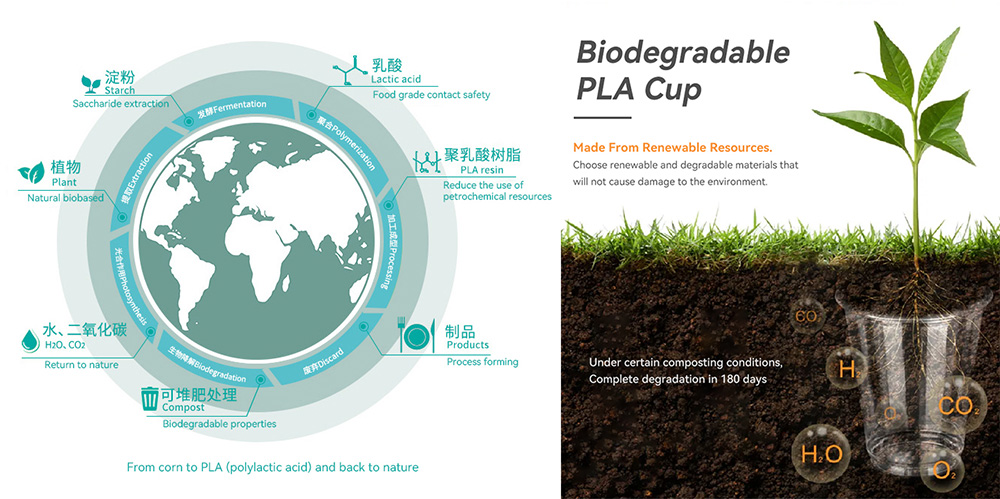
4. Factors Influencing Price Differences Between Biodegradable and PET Cups
4.1 Supply Chain and Raw Material Availability
Biodegradable materials like PLA are derived from agricultural crops, which are subject to seasonal fluctuations, climate conditions, and market demand. For example, the price of corn or sugarcane can vary based on weather conditions and crop yields, affecting the price of PLA. On the other hand, PET benefits from a stable and established supply chain based on petroleum, which results in more consistent pricing.
4.2 Production Volume and Economies of Scale
PET is produced in large quantities, and PET production is a well-established process with global manufacturing facilities. This large-scale production allows manufacturers to achieve economies of scale, lowering the unit cost of PET cups.
Biodegradable plastics, however, are still in the process of scaling up production. As the demand for biodegradable products increases, production capacity will likely grow, potentially lowering prices over time. However, for now, biodegradable plastics are produced in smaller volumes, making them more expensive than PET.
4.3 Government Policies and Regulations
Many governments around the world are introducing regulations to reduce plastic waste, which is driving demand for biodegradable plastics. For instance, the European Union has been phasing out single-use plastics and encouraging the use of biodegradable alternatives. While these policies may make biodegradable cups more popular, they can also contribute to higher prices due to the added regulatory compliance and manufacturing constraints.
5. The Business Perspective: Is the Higher Cost of Biodegradable Cups Justified?
5.1 Consumer Demand for Sustainability
Despite the higher upfront cost, there is a strong demand for eco-friendly packaging. According to a 2023 Global Data Consumer Survey, 74% of consumers are more likely to purchase products with eco-friendly packaging. This demand is particularly strong among Millennials and Gen Z, who are more willing to pay a premium for sustainable options.
5.2 Marketing and Brand Image
For businesses, adopting biodegradable packaging can be an important part of a broader sustainability strategy. By offering biodegradable cups, companies can differentiate themselves in the marketplace, appeal to environmentally-conscious consumers, and build a positive brand image. The additional cost can be offset by the added value of enhanced brand loyalty and the ability to market products as eco-friendly.
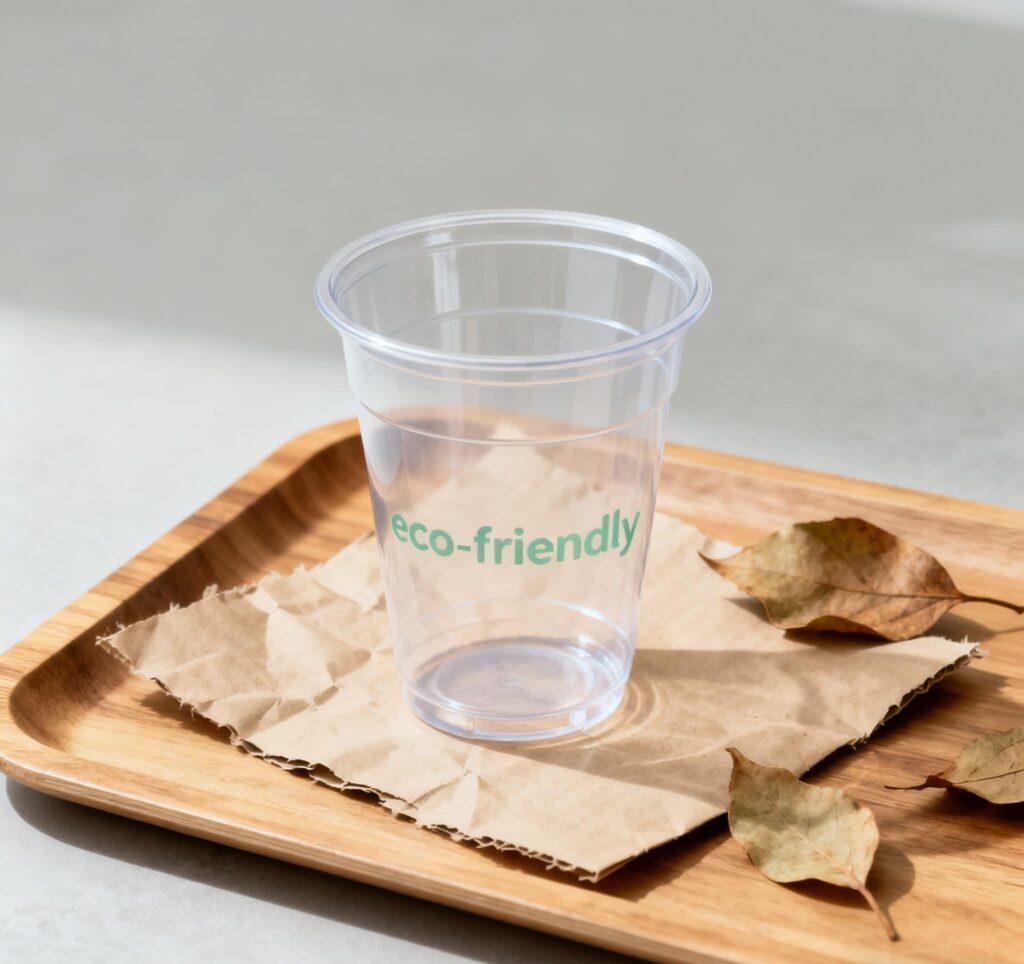
6. Conclusion: Is the Higher Cost of Biodegradable Cups Worth It?
The higher cost of biodegradable clear cups compared to PET cups is driven by multiple factors, including raw material costs, production complexity, and economies of scale. While biodegradable cups are more expensive upfront, their environmental benefits, such as reduced plastic pollution and lower carbon footprints, make them a viable alternative to traditional plastics.
As consumer demand for sustainable products continues to grow, businesses that choose biodegradable cups are not only contributing to a more sustainable future but also benefiting from improved brand perception and customer loyalty.
The decision to use biodegradable cups should be made with careful consideration of both the environmental impact and the financial feasibility. For many businesses, the additional cost may be justified by the long-term benefits of adopting sustainable practices and appealing to a more eco-conscious consumer base.
Frequently Asked Questions (FAQ)
Q1: Why are biodegradable cups more expensive than PET cups?
A1: Biodegradable cups are typically more expensive due to the higher costs associated with the raw materials (such as cornstarch, sugarcane, or other renewable resources), the more complex manufacturing processes, and smaller production scales compared to PET. PET, being a petroleum-based plastic, benefits from a well-established and cost-efficient production chain.
Q2: Are biodegradable cups truly better for the environment than PET cups?
A2: Yes, biodegradable cups generally offer a lower environmental impact compared to PET. While PET can persist in landfills for hundreds of years, biodegradable cups (like PLA) decompose naturally over time when disposed of correctly in composting facilities. However, it’s essential to note that biodegradable cups require specific conditions to break down, and improper disposal could reduce their environmental benefits.
Q3: How much more expensive are biodegradable cups compared to PET cups?
A3: On average, biodegradable cups can cost anywhere from 20% to 40% more than PET cups. For example, a 500ml PLA clear cup might cost $0.12 to $0.18 per unit, while a similar-sized PET clear cup could cost $0.08 to $0.12 per unit. The price difference is mainly due to raw material costs and the specialized manufacturing processes required for biodegradable cups.
Q4: Can biodegradable cups be recycled?
A4: Biodegradable cups, like those made from PLA, are not recyclable in traditional recycling systems. They are best suited for industrial composting, where they break down into natural elements. However, the lack of widespread industrial composting facilities means that many biodegradable cups may end up in landfills, where they may not degrade as quickly as intended.
Q5: Are consumers willing to pay more for biodegradable cups?
A5: Yes, consumer demand for sustainable packaging is on the rise. A 2023 Global Data Consumer Survey showed that 74% of consumers are more likely to purchase products with eco-friendly packaging. Many consumers are willing to pay a premium for products packaged in biodegradable materials, particularly those concerned with environmental sustainability.
Q6: Can biodegradable cups replace PET cups entirely?
A6: While biodegradable cups are an excellent alternative for many businesses looking to reduce their environmental impact, they are not a one-size-fits-all solution. Biodegradable cups may not be suitable for every application, particularly if composting facilities are not available. PET cups, on the other hand, remain a cost-effective and durable solution, though they come with environmental challenges due to their non-biodegradable nature.
References
-
United Nations Environment Programme (UNEP) – Plastic Pollution Report
UNEP Plastic Pollution Report -
Global Data Consumer Survey (2023)
Global Data Consumer Survey (This is a general link to GlobalData’s consumer survey reports. You may need to search for the specific 2023 survey.) -
Journal of Cleaner Production – Carbon Footprint of PLA vs. PET
Journal of Cleaner Production – Carbon Footprint Comparison (The Journal’s website. You can find the specific study by searching within their articles.) -
Environmental Protection Agency (EPA) – Recycling Rates for PET
EPA Recycling Rates for PET -
ResearchGate – Plastic Waste and Recycling: A Comprehensive Review
ResearchGate – Plastic Waste and Recycling
Copyright Statement© 2025 Dashan Packing. All rights reserved.
This article is an original work created by the Dashan Packing editorial team.All text, data, and images are the result of our independent research, industry experience,and product development insights. Reproduction or redistribution of any part of this contentwithout written permission is strictly prohibited.
Dashan Packing is committed to providing accurate, evidence-based information andto upholding transparency, originality, and compliance with global intellectual property standards.


